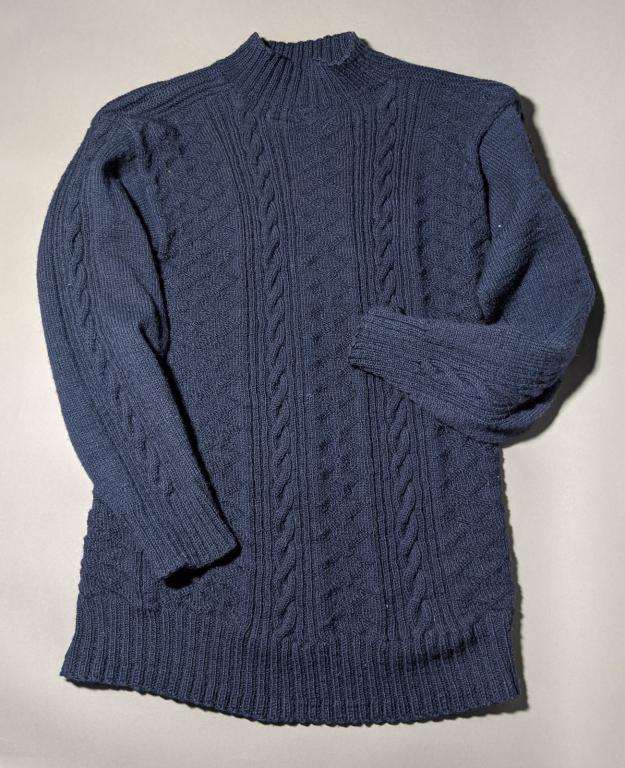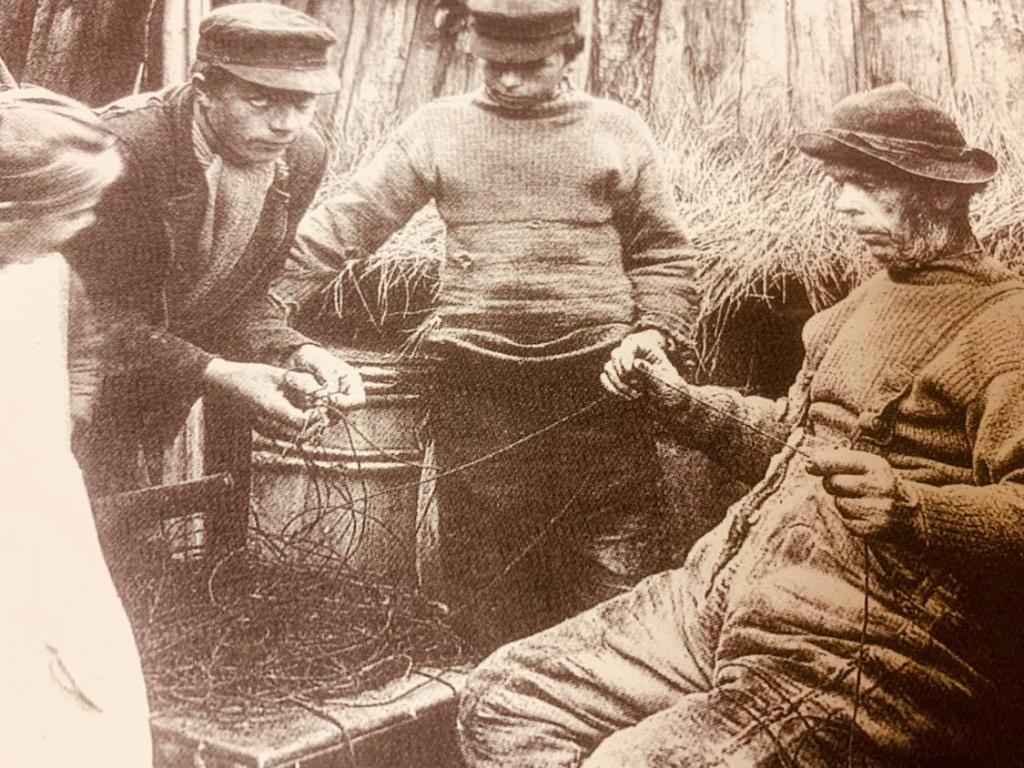
Weaving Yarns: Gansies, Folklore and Superstition
By Melissa Davies
This story belongs to a ten-part series of stories gifted by Nairn Museum. Many thanks to Melissa Davies, the director of Nairn Museum, for kindly gifting these stories to the Spirit: Stories archive.
A gansey is a knitted, woollen, pullover traditionally worn by fishermen around the British Isles and beyond. They were practical, comfortable and warm, providing protection from harsh conditions at sea. Many ganseys were beautifully patterned and there are hundreds of different designs using simple combinations of knit and pearl stitches. Different villages had patterns or pattern combinations that were unique to an area. In 2010, the Moray Firth Partnership set up the Gansey Project to find and record different patterns in this area. Around 40 ganseys were donated to the project and styles varied greatly.
As well as gathering bait, baiting hooks, smoking haddocks (Speldings), mending nets and selling the fish, the fisherwomen would knit various garments, including gansies. A few women were renowned for knitting, or 'wyving' and one was known as 'Wyvin Jean'. Knitters would create patterns that would represent everyday features of their coastal and fishing life, like waves, nets, ropes and herring bones. The Nairn ganseys display complex pattern combinations. Early photos from Nairn show a variety of rib patterns were used as well as vertical patterns, including chevrons and herringbone. Various gansey patterns were knitted by Miss Urquhart of Inverness and donated to Nairn Museum in 2001 (as in the photos below). By the late 1960s, the tradition of knitting ganseys was dying out.
 A navy blue, knitted Gansey jumper
A navy blue, knitted Gansey jumperImage provided by Nairn Museum/ Melissa Davies
Fishertown and Gansey Myths
A modern myth is that all fishing communities had unique gansey patterns in order to identify fishermen that drowned at sea. There is no real proof of this but it is true that a gansey could have been used as identification and a knitter would have been able to identify her own work. Another superstition is that if a gansey was not fully knitted by the stroke of midnight on New Year's eve it was bad luck and it would not be completed as the devil could be in it. If a gansey was still on the needles when the person it was being knitted for passed on, the gansey would not be completed. It would be unravelled and the wool kept aside for at least a year before being re-used to avoid the spirit of the deceased remaining with the garment.
Superstitions of the Fisherfolk
The fishing community at Nairn, like others in the land, was very superstitious. Various customs had to be observed. There are many documented superstitions such as not whistling in case you summoned up the devil or gale-force winds at sea. Wearing green was warned against as it is the colour of the land and your boat could be drawn onto shore. Green was the colour of grief according to some Lossiemouth fishing communities.
In Nairn, certain animals such as pig, swine and salmon were not mentioned by name for fear of bad luck. Meeting a minister (a sky pilot) or a red haired woman on the way to the boats would mean men would turn back home. A black cat crossing the path was also bad luck. To dispell bad luck, it was a custom to shout out 'cauld iron' and touch a piece of iron on the boat.
Another belief in Nairn was that when embarking on a fishing trip from the shore or harbour it was crucial that the boats' bows were turned with the sun in a clockwise direction, otherwise bad luck was bound to follow. It was also considered unlucky to burn fishbones or the shells of bait. One rhyme on the subject goes:
'Bile me, Fry me,
But dinna burn my banes,
Or I'll lay scarce,
On your hearth stane'.
Nairn fishermen believed that a boat built with 'she-oak' sailed faster by night than day. She-oak is chestnut, lighter than white-oak, and believed to have certain magical powers. Also considered unlucky was clearing fish scales out of the boat before a fishing trip had finished. It was believed that no more fish would be brought into the boat if this happened.
On New Year's day the fisher folk would go down to the beach, fill a bottle with salt water and collect seaweed. The water was sprinkled around the house and the seaweed placed above the door, on the hearth and in the roof-beam. This was thought to bring good luck in the coming season. Practices such as this were condemned by the Kirk but any 'terrors of eternal damnation' did not suppress the old customs or succeed in subduing the independence of character of the fisher folk.
 The Community at Fishertown, Nairn
The Community at Fishertown, NairnImage provided by Nairn Museum/ Melissa Davies
Fishermen from the Fishertown community shown at work on shore (L) and at the docks (R) in this archive collection from Nairn Museum.
 Image provided by Nairn Museum/ Melissa Davies
Image provided by Nairn Museum/ Melissa Davies
We Want to Hear From You!
Share your stories and memories of Nairn
Stories are at the heart of what we do as a project and we are always looking to learn more about what the Highlands and Islands means to people who live, work, and visit here. Nairn is an iconic part of the Highlands, with a rich natural and cultural heritage to discover. We would love to know, what are some of your favourite memories or stories related to Nairn? Tell us below, we can't wait to hear from you!
Click here to share your story through our online story portal